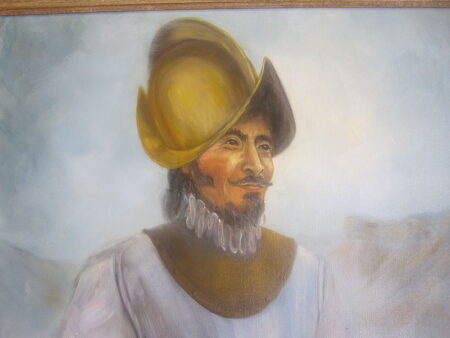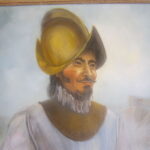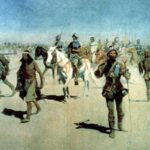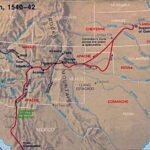Francisco Coronado
Explorer
Age of Discovery
Quick Facts:
He explored the southwestern part of the United States, which helped claim the land for Spanish colonization
Introduction
Francisco Coronado was a Spanish governor in what is modern day Mexico who went on to explore the southwest United States. His expedition was one that was prompted by stories of myth and riches. He was looking for the fabled Seven Cities of Gold. This journey took him into new areas not yet previously explored by Europeans. His travels went from present day Mexico, into parts of Arizona, New Mexico, Texas and up to present-day Kansas. He did not find this fabled city of riches. But he and his men found something else that people from far and wide come to see even still today – the Grand Canyon.
Biography
Early Life
Francisco Vásquez de Coronado was born in Salamanca, Spain in 1510. Although his family name was Vásquez, the English do not follow the same naming system. So overtime, he became known just as Francisco Coronado.1 He was the second son of Juan Vásquez de Coronado and his wife Isabel de Luján. They were a family of nobility and they owned a large estate.2 Not very much is known of Coronado’s early life. But because of his family’s status, young Francisco would have received a pretty good education. In these days, the eldest son would inherit his parent’s status and money. Since Francisco was the second son, he would be expected to work and make his own fortune. Juan Coronado worked for a man named Iñigo López de Mendoza, the governor of Granada, Spain. Iñigo had a son named Antonio, with whom Francisco became friends with. This friendship would lead Coronado to new and great opportunities.
During this period, several Spanish conquistadors had invaded many parts of the New World, and began setting up colonies. The Spanish empire named the territory New Spain – today the area is called Mexico. In April 1535, Antonio de Mendoza was made viceroy – someone who is appointed to rule a colony – of New Spain.3 Mendoza asked Coronado to join him, and work as his assistant. While in New Spain, Coronado married Beatriz de Estrada, who came from a wealthy family. Once married, Coronado inherited half of her wealth.4 Coronado became an important military commander helping to settle arguments between the natives and the Spaniards. In 1538, he was made governor of New Galicia, a province in western Mexico. Coronado was now wealthy, respected, and a leader in the New World. Mendoza and Coronado had heard stories from another Spanish explorer named Cabeza de Vaca, about a place known as the Seven Golden Cities of Cibola. It was believed that these Native American cities were filled with riches. So Mendoza chose Coronado to lead an expedition, find and explore these cities, and conquer the area and treasures in the name of Spain.
Voyages
Principal Voyage
Francisco Coronado began his expedition in February 1540.5 He had about 300 Spanish soldiers, several hundred natives, and herds of horses, cattle, and other livestock. They were traveling to lands northeast of New Galicia. This area had yet to be explored by the Spanish, even though they controlled much of the land. They began by heading north, along the West Coast of Mexico. They then went through Culiacan, the Yaqui River, and crossed the mountains into present day Southeast Arizona.6 In July 1540, Coronado and his men came upon what they thought was their first discovery of the golden cities of Cibola. What they actually came upon was the Native American pueblos of present day New Mexico Zuñi tribe.7 Pueblo is Spanish for “village” or “town.” Pueblos were a group of homes lived in by Native Americans, especially the Pueblo people. Coronado came in and conquered the town of Hawikuh where he set up camp.
Cibola fell short of Coronado’s expectations. There were none of the gold or other riches he had expected to find. In the fall of 1540, they moved their base to the Rio Grande in what is now central New Mexico.8 Coronado soon sent out two scouting parties. One party, led by Garcia Lopez de Cardenas, became the first Europeans to discover the Grand Canyon. The other party found more pueblos in the Rio Grande Valley. In the Tiguex area (near modern day Albuquerque and Bernalillo, New Mexico) they began a battle agains the Pueblo natives. This battle lasted several months before it ended. After his men re-joined Coronado, they settled in for winter near what is now present day Santa Fe, New Mexico. Coronado was still disappointed that he had found no treasures. But his hope was restored in 1541 when he heard stories of a new land filled with riches.
Subsequent Voyages
After winter ended, Coronado was ready for the second part of his expedition. One of the native slaves had told Coronado of a new land to the northeast. The capital of this land, called Quivira, was said to be very rich. In April 1541, Coronado and his army marched toward Quivira. They crossed the Pecos river and Palo Duro Canyon. They soon arrived at the Great Plains where they saw herds of buffalo.9 They continued across the Northwest part of present day Texas and Oklahoma, and finally arrived at Quivira in present day Kansas. Coronado spent about a month exploring. They found a village of the Wichita Native American tribe, but found none of the riches his slave had told him. The slave confessed that he made up the story, so Coronado had him executed.10 Coronado returned to Cibola, where he spent another winter. After winter passed, they began their journey back to Mexico.
Later Years and Death
In the fall of 1542, Francisco Coronado and about 100 of his men returned to New Galicia. His mission had been unsuccessful. In 1544, Mendoza, disappointed with Coronado’s failure, had him removed as governor. Coronado went to Mexico city, where he lived a quiet life as a councilman. He died on September 22, 1554.
Legacy
Although Francisco Coronado’s journey was seen as a failure in his lifetime, he is recognized today for many achievements. He claimed many parts of land for Spain. He and his men are also the first Europeans to live among the Pueblo Indians, explore the Great Plains, and see the Grand Canyon.11 His description of the areas he explored helped create updated maps of the lands. Coronado’s explorations helped open up the southwestern United States for future Spanish colonization.
EndnotesImages





